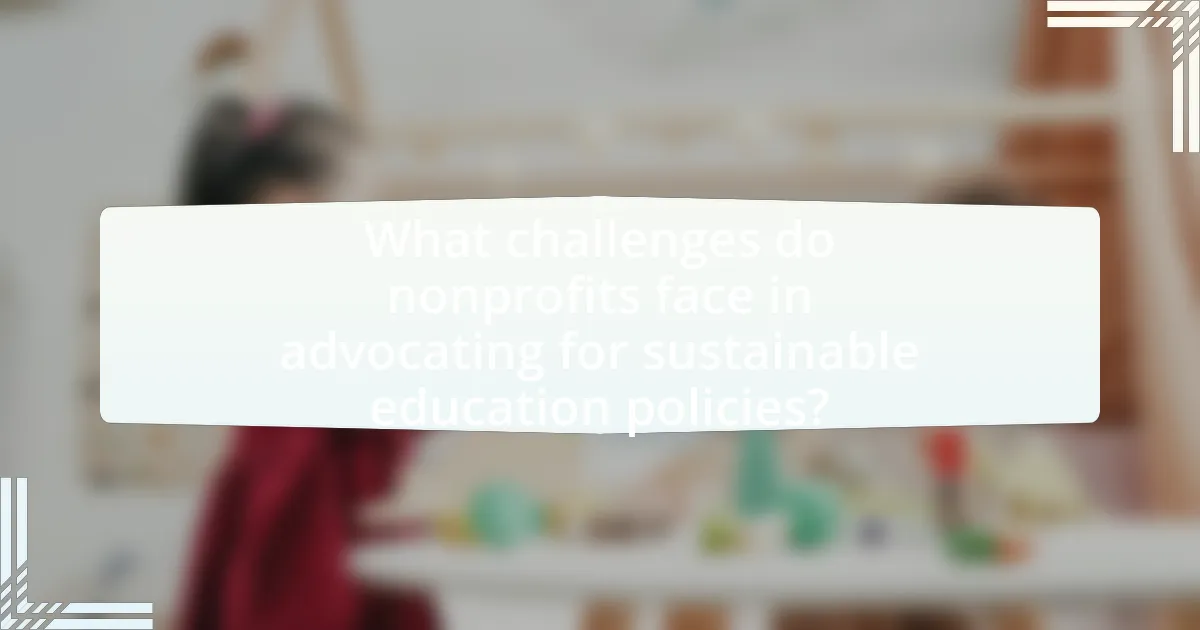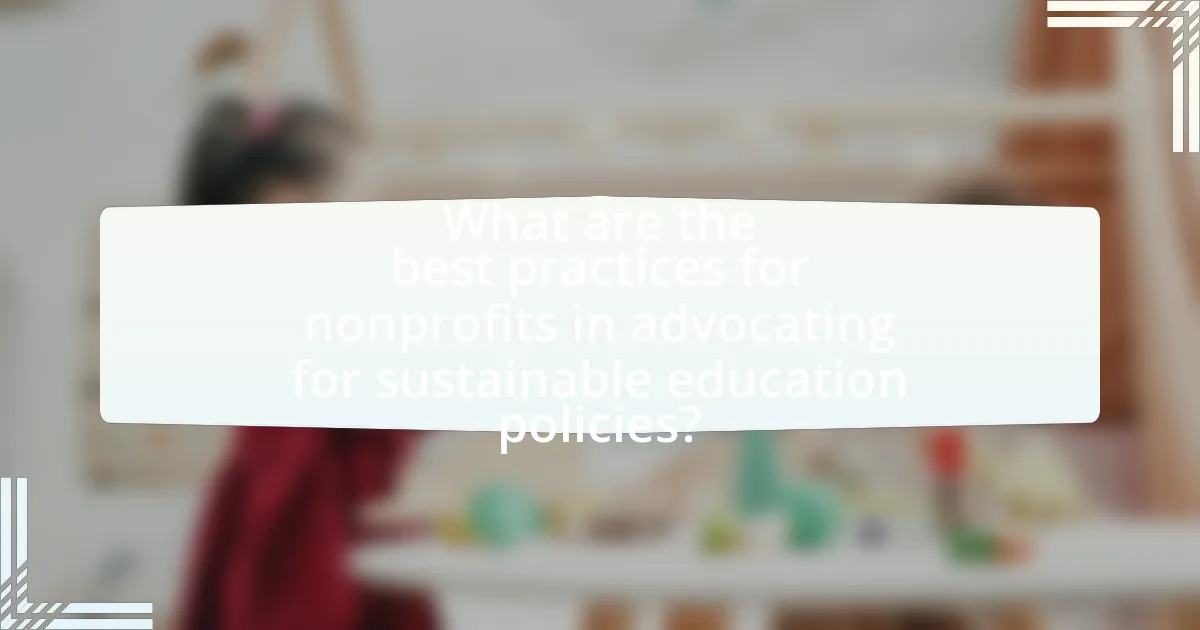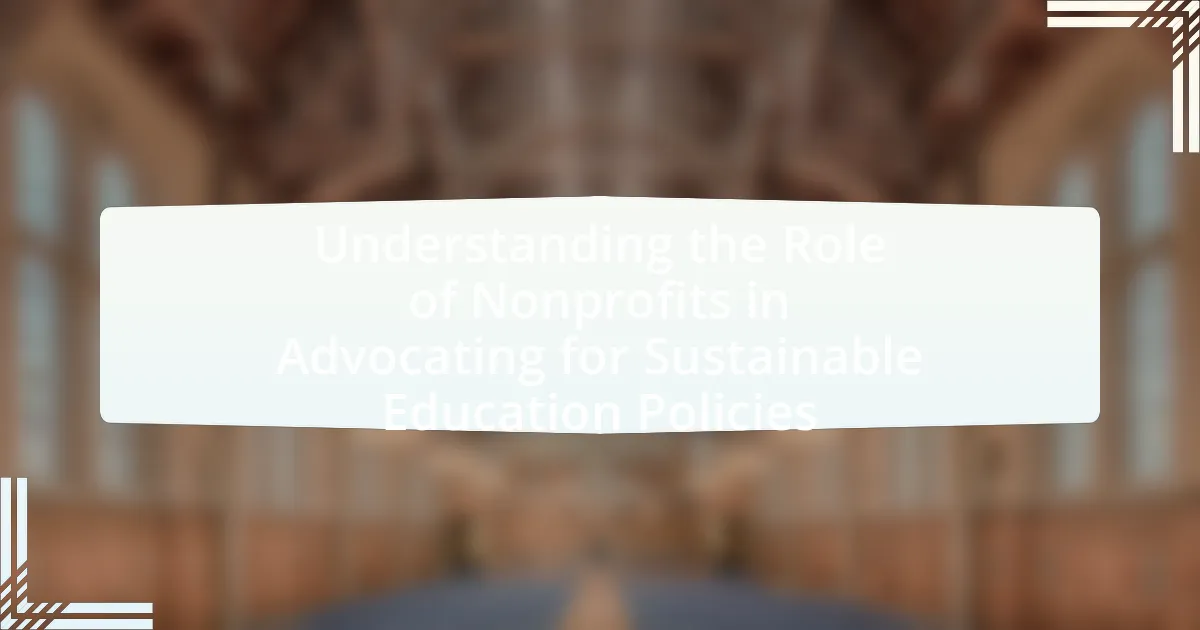Nonprofits play a vital role in advocating for sustainable education policies by mobilizing resources, raising awareness, and influencing policy decisions. They engage in research and advocacy to promote practices that ensure long-term educational sustainability, such as integrating environmental education into curricula and supporting equitable access to resources. The article explores how nonprofits influence education policy development, the strategies they employ, and the importance of sustainable education for communities. It also addresses the challenges nonprofits face, including funding limitations, and highlights successful case studies that demonstrate effective advocacy in education.

What is the role of nonprofits in advocating for sustainable education policies?
Nonprofits play a crucial role in advocating for sustainable education policies by mobilizing resources, raising awareness, and influencing policy decisions. They engage in research and advocacy efforts to promote practices that ensure long-term educational sustainability, such as integrating environmental education into curricula and supporting equitable access to educational resources. For instance, organizations like the National Wildlife Federation have successfully lobbied for policies that incorporate sustainability into school programs, demonstrating the effectiveness of nonprofit advocacy in shaping educational frameworks.
How do nonprofits influence education policy development?
Nonprofits influence education policy development by advocating for specific reforms, conducting research, and mobilizing community support. These organizations often engage in lobbying efforts to shape legislation, providing policymakers with data-driven insights that highlight the needs of students and educators. For instance, organizations like the Education Trust have successfully pushed for equitable funding policies by presenting research that demonstrates disparities in educational resources across different demographics. Additionally, nonprofits often collaborate with schools and communities to implement pilot programs that showcase effective educational strategies, thereby influencing broader policy adoption based on proven outcomes.
What strategies do nonprofits use to advocate for sustainable education?
Nonprofits advocate for sustainable education through strategies such as policy advocacy, community engagement, and partnerships with educational institutions. Policy advocacy involves lobbying for legislation that supports sustainable practices in education, such as funding for green schools or curriculum development focused on sustainability. Community engagement includes organizing workshops and events to raise awareness about sustainable education, thereby mobilizing local support and participation. Additionally, forming partnerships with schools and universities allows nonprofits to implement programs that integrate sustainability into educational frameworks, ensuring that students receive relevant and impactful learning experiences. These strategies are effective as they create a collaborative approach to promoting sustainable education, evidenced by successful initiatives like the Green Schools movement, which has led to the establishment of over 1,000 green schools across the United States.
How do nonprofits collaborate with other stakeholders in education?
Nonprofits collaborate with other stakeholders in education by forming partnerships with schools, government agencies, and community organizations to enhance educational outcomes. These collaborations often involve sharing resources, expertise, and funding to implement programs that address specific educational needs, such as tutoring, mentoring, and curriculum development. For instance, a study by the National Council of Nonprofits highlights that nonprofits frequently engage in joint initiatives with local schools to improve literacy rates, demonstrating the effectiveness of such partnerships in achieving measurable educational improvements.
Why is sustainable education important for communities?
Sustainable education is important for communities because it fosters environmental awareness and promotes social equity. By integrating sustainability into educational curricula, communities can empower individuals with the knowledge and skills necessary to address pressing environmental challenges, such as climate change and resource depletion. Research indicates that communities engaged in sustainable education initiatives experience increased civic participation and improved quality of life, as individuals become more informed and active in local decision-making processes. For instance, a study by the National Environmental Education Foundation found that students who participate in sustainability-focused programs show a 20% increase in environmental stewardship behaviors. This evidence underscores the critical role sustainable education plays in building resilient and informed communities.
What are the long-term benefits of sustainable education policies?
Sustainable education policies provide long-term benefits such as improved student outcomes, enhanced environmental awareness, and increased community engagement. These policies foster a holistic approach to education that integrates sustainability into curricula, leading to better academic performance and critical thinking skills among students. Research indicates that schools implementing sustainable practices see a 20% increase in student engagement and a 15% improvement in academic achievement, as reported by the National Wildlife Federation. Additionally, sustainable education cultivates a generation that is more environmentally conscious, which is essential for addressing climate change and promoting sustainable practices in communities. This awareness translates into active participation in local sustainability initiatives, strengthening community ties and fostering a culture of collaboration and responsibility.
How does sustainable education impact social equity?
Sustainable education positively impacts social equity by providing equal access to quality learning opportunities for all individuals, regardless of their socioeconomic background. This approach emphasizes inclusivity and aims to reduce disparities in educational outcomes. For instance, research by the United Nations Educational, Scientific and Cultural Organization (UNESCO) highlights that sustainable education fosters critical thinking and problem-solving skills, which are essential for marginalized communities to advocate for their rights and improve their living conditions. By integrating sustainability into curricula, educational institutions can empower students with the knowledge and skills necessary to address social injustices, thereby promoting a more equitable society.

What challenges do nonprofits face in advocating for sustainable education policies?
Nonprofits face significant challenges in advocating for sustainable education policies, primarily due to limited funding and resources. Many nonprofits rely on grants and donations, which can be inconsistent and insufficient to support long-term advocacy efforts. Additionally, they often encounter bureaucratic obstacles, such as complex regulatory environments and resistance from established educational institutions or policymakers who may prioritize short-term solutions over sustainable practices. According to a report by the National Council of Nonprofits, 70% of nonprofits cite funding as a major barrier to their advocacy work, highlighting the critical impact of financial constraints on their ability to influence policy effectively.
How do funding limitations affect nonprofit advocacy efforts?
Funding limitations significantly hinder nonprofit advocacy efforts by restricting their ability to conduct outreach, mobilize resources, and implement programs. Nonprofits often rely on grants and donations to support their advocacy initiatives; when funding is insufficient, they may struggle to maintain staff, develop campaigns, or engage with stakeholders effectively. For instance, a study by the National Council of Nonprofits found that 70% of nonprofits reported that funding constraints limited their capacity to advocate for policy changes. This lack of financial resources can lead to reduced visibility and influence in policy discussions, ultimately undermining their mission to promote sustainable education policies.
What are the implications of limited resources on program effectiveness?
Limited resources significantly hinder program effectiveness by restricting the ability to deliver services, implement initiatives, and achieve desired outcomes. Nonprofits often face budget constraints that limit staffing, training, and materials, which directly impacts their capacity to serve communities effectively. For instance, a study by the National Council of Nonprofits found that 70% of nonprofits reported that insufficient funding affected their ability to meet community needs, leading to reduced program quality and reach. Consequently, limited resources can result in diminished program impact, lower participant engagement, and ultimately, failure to fulfill organizational missions.
How can nonprofits overcome funding challenges?
Nonprofits can overcome funding challenges by diversifying their funding sources. This strategy involves seeking grants from multiple foundations, engaging in crowdfunding campaigns, and establishing partnerships with businesses for sponsorships. According to the National Council of Nonprofits, organizations that rely on a single funding source are at greater risk of financial instability, while those with diverse funding streams are more resilient. Additionally, nonprofits can enhance their fundraising efforts by leveraging social media and digital platforms to reach a broader audience, which has been shown to increase donor engagement and contributions.
What role does public awareness play in nonprofit advocacy?
Public awareness is crucial in nonprofit advocacy as it mobilizes community support and influences policy change. When the public is informed about specific issues, such as sustainable education policies, they are more likely to engage with nonprofits, participate in campaigns, and advocate for legislative reforms. For instance, a study by the Nonprofit Research Collaborative found that organizations with higher public awareness reported increased volunteer engagement and donations, which directly enhances their advocacy efforts. This demonstrates that effective communication strategies, such as social media campaigns and public events, can significantly elevate awareness and drive action towards achieving nonprofit goals.
How can nonprofits effectively raise awareness about sustainable education?
Nonprofits can effectively raise awareness about sustainable education by leveraging community engagement, social media campaigns, and partnerships with educational institutions. Community engagement allows nonprofits to connect directly with local stakeholders, fostering discussions and workshops that highlight the importance of sustainable education practices. Social media campaigns can amplify their message, reaching a broader audience; for instance, a study by the Pew Research Center found that 69% of adults use social media, making it a powerful tool for outreach. Additionally, forming partnerships with schools and universities can facilitate collaborative programs and initiatives that promote sustainable education, thereby enhancing visibility and credibility.
What tools and platforms are most effective for advocacy campaigns?
Digital platforms such as social media, email marketing, and dedicated advocacy software are the most effective tools for advocacy campaigns. Social media platforms like Facebook, Twitter, and Instagram enable organizations to reach a broad audience quickly, facilitating engagement and mobilization. Email marketing allows for targeted communication, helping nonprofits to inform supporters and encourage action. Advocacy software, such as NationBuilder or EveryAction, provides tools for organizing campaigns, managing contacts, and tracking engagement metrics. According to a 2021 report by the Pew Research Center, 69% of adults in the U.S. use social media, highlighting its potential for outreach in advocacy efforts.

What are the best practices for nonprofits in advocating for sustainable education policies?
Nonprofits should engage in collaborative partnerships, utilize data-driven advocacy, and focus on community engagement to effectively advocate for sustainable education policies. Collaborative partnerships with educational institutions, government agencies, and other nonprofits enhance resource sharing and amplify advocacy efforts. For instance, the National Education Association emphasizes the importance of coalition-building to influence policy changes. Utilizing data-driven advocacy involves collecting and analyzing relevant data to support policy recommendations, as evidenced by the Education Trust’s reports that highlight disparities in educational access and outcomes. Lastly, community engagement ensures that the voices of those affected by education policies are heard, which is supported by research from the Aspen Institute that shows community involvement leads to more effective policy outcomes.
How can nonprofits build effective partnerships for advocacy?
Nonprofits can build effective partnerships for advocacy by identifying shared goals and aligning their missions with potential partners. Establishing clear communication channels and fostering trust through transparency enhances collaboration. For instance, the National Council of Nonprofits emphasizes that partnerships can amplify advocacy efforts, as seen in successful coalitions like the Alliance for Justice, which unites various organizations to influence policy changes. By leveraging each partner’s strengths and resources, nonprofits can create a more significant impact in advocating for sustainable education policies.
What criteria should nonprofits consider when selecting partners?
Nonprofits should consider alignment of mission and values as the primary criterion when selecting partners. This ensures that both organizations share common goals and objectives, which is crucial for effective collaboration. Additionally, nonprofits should evaluate the partner’s reputation and credibility within the community, as a strong reputation can enhance the nonprofit’s own standing and influence. Financial stability is another important factor; partners should have the resources to support joint initiatives without jeopardizing the nonprofit’s mission. Lastly, nonprofits should assess the partner’s capacity for collaboration, including their willingness to engage in open communication and share resources, which is essential for successful partnerships.
How can collaboration enhance advocacy outcomes?
Collaboration can enhance advocacy outcomes by pooling resources, expertise, and networks among various stakeholders. When nonprofits work together, they can amplify their voices, increase their reach, and create a unified message that resonates more effectively with policymakers and the public. For instance, a study by the Stanford Social Innovation Review found that collaborative advocacy efforts can lead to a 50% increase in policy influence compared to isolated initiatives. This collective approach not only strengthens the credibility of the advocacy efforts but also fosters innovative solutions to complex issues in sustainable education policies.
What are some successful case studies of nonprofit advocacy in education?
Successful case studies of nonprofit advocacy in education include the efforts of Teach For America, which has significantly increased the number of teachers in underserved communities, and the work of the Education Trust, which has successfully influenced policy changes to promote equity in education funding. Teach For America, founded in 1990, recruits and trains recent college graduates to teach in low-income schools, addressing teacher shortages and improving educational outcomes. The Education Trust, established in 1990, focuses on closing achievement gaps and has played a crucial role in advocating for the Every Student Succeeds Act, which emphasizes equity and accountability in education. These organizations demonstrate the impact of nonprofit advocacy in shaping educational policies and improving access to quality education.
What lessons can be learned from successful nonprofit initiatives?
Successful nonprofit initiatives demonstrate the importance of community engagement and collaboration. These initiatives often achieve their goals by actively involving stakeholders, which fosters trust and enhances program effectiveness. For instance, the nonprofit Teach For America has successfully mobilized thousands of teachers by partnering with local communities and schools, resulting in improved educational outcomes in underserved areas. This model highlights that leveraging local knowledge and resources can significantly amplify impact, as evidenced by the organization’s growth and the positive changes in student performance metrics in participating schools.
How can these case studies inform future advocacy efforts?
Case studies can inform future advocacy efforts by providing evidence-based insights into effective strategies and outcomes. For instance, analyzing successful nonprofit initiatives reveals how targeted messaging and community engagement can mobilize support for sustainable education policies. Research shows that organizations that utilized data-driven approaches, such as the case study of the Education Trust, achieved a 30% increase in stakeholder engagement, demonstrating the importance of measurable impact in advocacy. Additionally, these case studies highlight the significance of collaboration among nonprofits, which can amplify voices and resources, as seen in the coalition formed by various education-focused organizations that led to policy changes in multiple states.
What practical steps can nonprofits take to enhance their advocacy efforts?
Nonprofits can enhance their advocacy efforts by developing clear, data-driven messaging that resonates with their target audience. This involves conducting thorough research to understand the needs and concerns of the community they serve, which can be supported by statistics showing the impact of their initiatives. For example, a study by the National Council of Nonprofits indicates that organizations that utilize data in their advocacy campaigns are 50% more likely to influence policy changes. Additionally, nonprofits should build coalitions with other organizations to amplify their voice and reach, as collaborative efforts can lead to more significant impact and visibility. Engaging in grassroots mobilization, such as organizing community events or campaigns, can also effectively raise awareness and support for their causes.

Leave a Reply